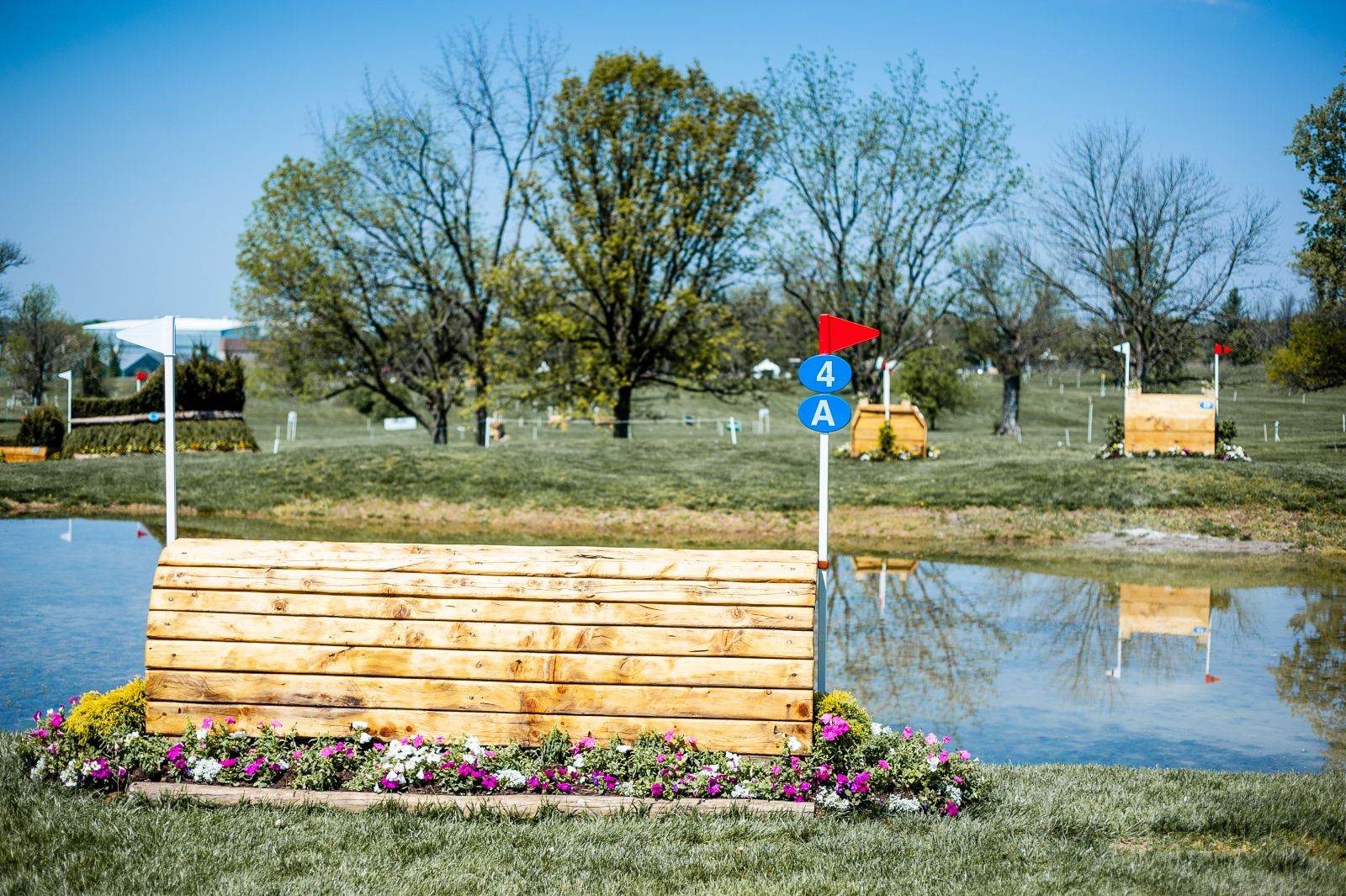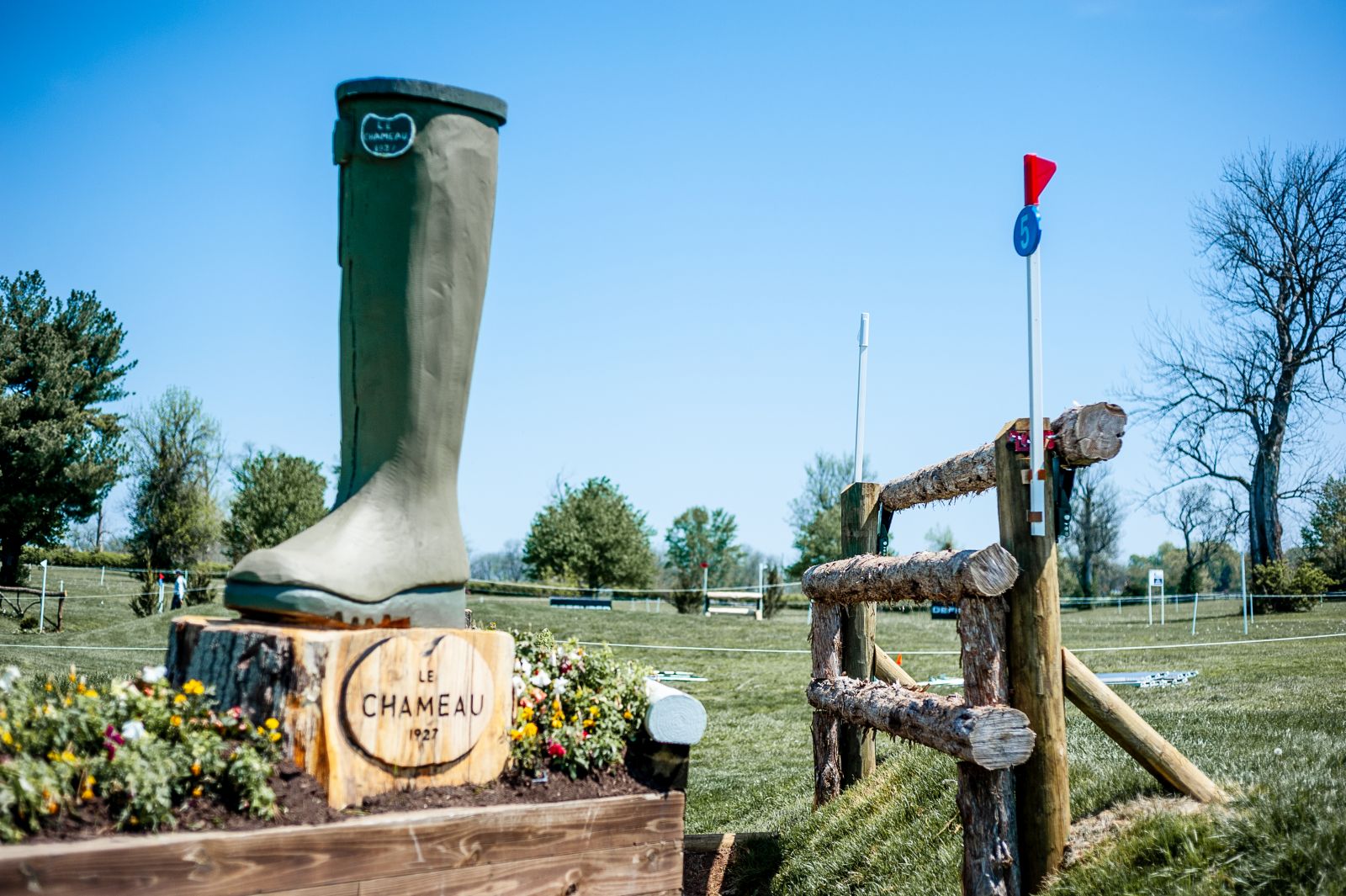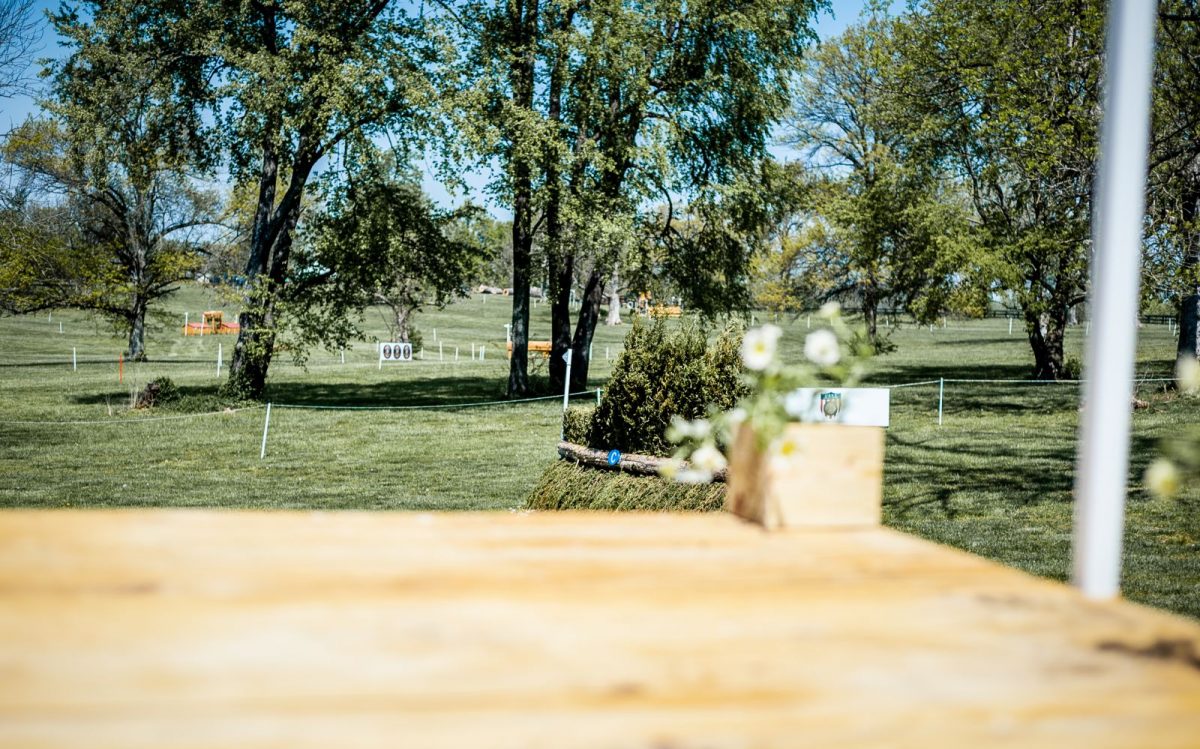
3, 2, 1, go! Have a great ride. Photo by Tilly Berendt.
I feel I’m running low on descriptive phrases, because every time I sit down to write a preview of one of Derek di Grazia’s courses, the first thing that comes to mind is inevitably “classic Derek”. It’s probably not the most original idea to start every preview as such, so I’ll do some thinking on a different starter.
But it’s true. Each course designer has a signature style, made evident as you walk the carefully planned tracks and lines laid out for the competitors come Saturday. For Derek, the job is about making the most use of the undulating terrain that he knows so well here at the Kentucky Horse Park. He’s had the gig here since 2011, starting his thought process for the next season’s iteration nearly as soon as the final horse has crossed the finish flags.
“I think in little ways, the course changes every year,” Derek commented. “I like to think even though I think we certainly have features here which I think will always be used, and we’ll try to maybe develop some new ones here and there, but I think that it’s sort of how you lay it all out. It’s a matter of trying to mix it up each year and giving riders something new to look at, and also I think having something that’s different so that the the spectator to come every year we’re going to see a different course.”

One down, 27 to go. Photo by Tilly Berendt.
The most valuable commodity in eventing is land. The 2023 CCI5* cross country makes excellent use of several hundred acres of bluegrass to create a track that suits a good galloper and allows riders to establish a rhythm early on rather than turning them in circles. The out-and-back nature of the track takes advantage of every elevation change and undulation — and if you’re Derek, you’ve spotted each of the above and strategically placed a fence in a way that makes even a straightforward table require a good bit of thinking and footwork.
Let’s dive in to Derek’s designs, which as always feature incredibly built and intricately carved designs by the building team led by Mick Costello, Tyson Rementer, Dave Leonard, Levi Ryckawaert, and Graham Schick.
The optimum time for the CCI5* track is 11 minutes, 26 seconds — 25 seconds longer than the 2022 track and the longest optimum time dating back to at least 2013. As a result, fitness will be a key factor (as it typically is), and riders will want to look after their horses early on in order to push through that final minute safely.

Fence 3, the Meadow Oxer. Photo by Tilly Berendt.
Early Going
The competitors will have three fences to get them underway: The Red, White and Bluegrass (1), Cedar Lodge (2), and Meadow Oxer (3). These early fences are your typical rhythm builders, and shouldn’t cause any issues unless a horse is having difficulty establishing said rhythm early on.

Fence 4ABC, The MARS Sustainability Bay. Photo by Tilly Berendt.
Down to Business
Our first combination question will come, as has been usual in past years, at fence 4ABC, the MARS Sustainability Bay. Riders will approach this question from a different direction this year, dropping in over a rolltop and kicking forward and up a steep include to a narrow table at B before a handy, right-handed turn to an angled brush at the C element. The forward-thinking nature of the striding here will encourage riders to get into their attacking pants early on, before the more complex questions come up later.

Fence 5, the Le Chameau Leap. Photo by Tilly Berendt.
A long gallop into the steeplechase field will bring the riders to the beautifully built Le Chameau Leap, a fairly innocuous upright rail over a ditch with a welcoming flat landing on the back side. This will give the riders a nice, boldness-boosting ride, which should set them up well after a left-handed turn to fence 6ABCD, the famous Park Question.
- Photo by Tilly Berendt
- Photo by Tilly Berendt.
The Park Question is typically set up as a coffin complex, and in this year’s version we’ll see the competitors tested on their ability to organize and turn right to test their accuracy — they’ll only have a small handful of strides to make a clean right turn after popping the ditch at B to navigate two narrow and tall triple brush arrowheads. The B and C are set on *just* enough of a non-straight line to begin to separate the cream from the crop here, as riders who get popped out of position over the ditch will struggle to get through the brushes neatly.

Photo by Tilly Berendt.
Fence 7, the Fox’s Den, will sneak up on some unprepared combinations, as it’s set back into a small grove of trees and around a relatively blind right hand turn following a gallop up the hill. To add insult to injury, the fence is built to quite narrow specs, making it that much more of an accuracy question. Depending on the weather, shadows could play a factor here — one advantage of an overcast day.
- Photo by Tilly Berendt.
- Photo by Tilly Berendt.
- Photo by Tilly Berendt.
The next combination — a new one on the track this year — will come up at fence 8ABC, where riders will get a good shot over the massive, airy Equestrian Events Trifecta triple bar. The B element is a 1.90m spread narrow table, followed by an open oxer. This line is on a slight downhill, which could pull a keen horse down into a drive-by, but there are several options for lines for riders to choose.
This is another marker of a Derek track: he doesn’t want the riders to be too married to a number of strides, instead he’d prefer that they ride the stride they feel and focus instead on keeping their line.

The infamous Ditch Brush. Photo by Tilly Berendt.
Into the Infield
Here at Kentucky, horses and riders cross across three massive fields, each with its own sense of terrain and character. From the combination at 8, the riders will gallop down the hill into the infield where most of the tailgating and spectators can be found. They’ll first tackle the Ditch Brush (9), which generally won’t cause too many issues and if anything looks a bit shorter on the brush height than it has in previous iterations. It does make a great photo, though, so be sure to stop by for a few rides.
After the Ditch Brush, it’s on to the Rolex Grand Slam Challenge at 10ABCD, where Derek has made use of a BC element to really challenge riders to commit to a decision. Multiple letters on one fence indicate that the rider cannot opt for an option if they have difficulty at that element. It’s a bit of alphabet soup used by designers, and so riders will need to commit to one route or the other, as if they have an issue at the brush corner in the water here they’ll have to figure out a way to get over that fence before continuing on up a mildly steep incline to a narrow brush chevron.
From here, the riders will gallop up the biggest hill on the track en route to the back end and turning point at Pete’s Hollow (12ABC). A big log will welcome riders into the Hollow, after which they’ll roller coaster down a steep hill to navigate a pair of angled logs. There is only one route here, where typically you’d see a long route, and this will once more be an exercise not in counting strides but in managing the horse that’s underneath you. The angles required to keep a line between the logs will be a stiff challenge, additionally.
After a nice pull down the hill, a great opportunity for horses to take a breath and catch a second wind, riders will pop the Blade and Bow Bourbon Table at 13 before tackling the Narrow Knolls at 14AB. This question makes good use of the two mounds set on an angle, making this another right-handed accuracy question, with two wide and narrow tables to up the ante in terms of challenge.
Fence 15, the Wofford Rails, is my personal favorite fence on the track this year. It’s a new addition built and placed in homage to the late and loved Jimmy Wofford. It’s an interesting question, and while I think it’ll ride just fine, it’s by no means a gimme. On first glance, my thought was “huh, Jimmy gets a single fence. He might’ve wanted more of a challenge than that.”
And then I walked the line to approach the wide oxer. Just before the takeoff point, there’s a small undulation with a mild slope to the right. I’d be surprised if we saw any major issues here, but the shrewd placement of this fence will make it one that riders will need to have their line found and committed to in order to get a good shot. In other words, it’ll require some thinking and reacting to what’s happening under you — a core philosophy Jimmy instilled in his students throughout his entire career. I think he’d be pleased.
Into the Splash
Next, the riders will hop into the iconic Defender Head of the Lake at 16, 17 and 18. There’s always a good amount to do at this question, and what stands out to me at this version is the different types of jumps each fence will require. After a big drop in over a gorgeous carving of…trout? bass? tuna?…riders will need to quickly gather up and organize to make a neat hop over a second fish in the water. From there, they’ll make a left-handed turn to a set of upright rails (they’ll have the option to go to the left or the right side), which will require a neat, show jumping ride. From there, they’ll bound back into the water and gather up for a big bank out of the water, with one short stride before a meaty left-handed brush corner.
Adjustability will be tantamount here, and the horses will need to be paying attention and riders will need to be committed to their plan here to navigate this on the first try.
Turning for Home
After popping the Creekside Oxer at 19, the next challenge will be at the top of the hill on the way back toward home. The Normandy Bank at 20AB and 21 is another steering question, and at this point riders will be looking to get their horses home as they begin to tire. Adjustability is one of the first things you begin to lose when fatigue sets in, so the fitter and nippier horses will have an easier time getting up the bank and making a neat left-hand turn to a sharp angle of double brushes. Fortunately for some, the two brushes are separately numbered, so a greener horse or a tired horse could be eased with a circular route over the 20B and 21 elements if needed.
Three beefy combinations stand between this point in the course and the finish, though Derek has also included several single fences that should offer a let-up to encourage the horses home in good spirits. First up of the remaining trio of combinations is the gorgeously adorable corgi fence at Cosequin Cove (23ABC). You’ll want to kick for the B element, a 1.45m brush oxer out of the water, before turning left to set up for a hefty solid corner at the C element. Horses that have lost the rideability factor at this point in the course will struggle to sort their feet out, though there is an option to go long should you have an issue or a tiring horse here.
There will be three single fences to pick off before the final combination, and one that stands to pose plenty of trouble as the penultimate question on course. The Angled Trakehners (27AB) are set on three strides for the direct option, with another option placed as a long route. I’d guess we’ll see a few pairs opt for the safer route here. I’d personally prefer to see a frangible or MIM-clipped fence here at this point in the course, but the round shape of the trakehner logs tends to be more inviting for even a tired horse.

You’ve made it! Photo by Tilly Berendt.
From here, it’s a straight shot to the final jump, the welcome sight of the Lucky Horseshoe flanked by Land Rover Defenders. This is an inviting rolltop with brush on top that will be a sight for many sore eyes after a grueling 11 and a half minutes.
You can view the entire CCI5* track thanks to CrossCountryApp below or here. There are several videos featuring Derek’s commentary on various questions, so it’s worth a flip through.
@media screen and (max-width: 500px) { .crosscountry-embed-container { padding-bottom:150% !important; } }
Want a virtual walk? Take a peek at our course preview reel on Instagram (click here if the embedded post below does not display in your browser):
Keep scrolling for a full gallery of fences on the 5* track.
The Lexington CCI4*-S riders will be the first to see tomorrow, and you can check out their shorter-but-still-stiff track below or here.
@media screen and (max-width: 500px) { .crosscountry-embed-container { padding-bottom:150% !important; } }
Sara Kozumplik and her old hand partner, Rubens d’Ysieux, will be the first to see in the 4* at 9:15 a.m. EST. Buck Davidson and Erroll Gobey will be the first to see at 1:20 p.m. in the 5*.
View 4* Ride Times
View 5* Ride Times
- 3, 2, 1, go! Have a great ride. Photo by Tilly Berendt.
- One down, 27 to go. Photo by Tilly Berendt.
- Fence 3. Photo by Tilly Berendt.
- Photo by Tilly Berendt.
- Photo by Tilly Berendt.
- Photo by Tilly Berendt
- Photo by Tilly Berendt.
- Photo by Tilly Berendt.
- Photo by Tilly Berendt.
- Photo by Tilly Berendt.
- Photo by Tilly Berendt.
- Photo by Tilly Berendt.
- Wofford’s Rails at 15. Photo by Sally Spickard.
- Photo by Sally Spickard.
LRK3DE: [Website] [5* Times] [5* Scores] [4* Times] [4* Scores] [Schedule] [Live Stream] [Tickets] [EN’s Form Guide] [EN’s Coverage] [EN’s Ultimate Guide]
[Click here to catch up on all of EN’s coverage of the 2023 Land Rover Kentucky Three-Day Event]
Want more LRK3DE info each day during competition? Sign up for the free LRK3DE Daily Digest email, which will be sent each day through Monday, May 1. Find all of EN’s latest coverage, sponsor promotions and discounts, chances to win daily giveaways, and much more! Click here to sign up.






























































